
The Cathach of St. Columba, known as the Cathach, is a late 6th century Insular psalter. It is the oldest surviving manuscript in Ireland, and the second oldest Latin psalter in the world.
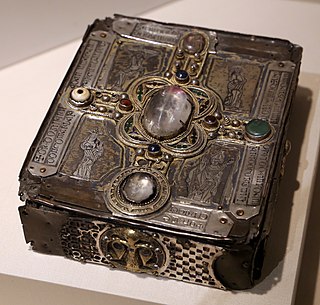
A cumdach or book shrine is an elaborate ornamented metal reliquary box or case used to hold Early Medieval Irish manuscripts or relics. They are typically later than the book they contain, often by several centuries. In most surviving examples the book comes from the peak age of Irish monasticism before 800, and the extant cumdachs date from after 1000, although it is clear the form dates from considerably earlier. The majority are of Irish origin, with most surviving examples held by the National Museum of Ireland (NMI).
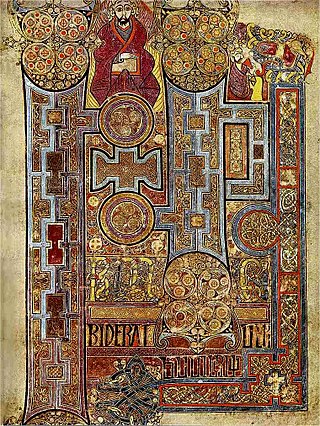
Insular art, also known as Hiberno-Saxon art, was produced in the post-Roman era of Great Britain and Ireland. The term derives from insula, the Latin term for "island"; in this period Britain and Ireland shared a largely common style different from that of the rest of Europe. Art historians usually group Insular art as part of the Migration Period art movement as well as Early Medieval Western art, and it is the combination of these two traditions that gives the style its special character.

The National Museum of Ireland – Archaeology is a branch of the National Museum of Ireland located on Kildare Street in Dublin, Ireland, that specialises in Irish and other antiquities dating from the Stone Age to the Late Middle Ages.

The Kells crozier or British Museum Crozier is an early medieval Irish Insular crozier. It is often known as the "Kells Crozier", indicating an associating with the Abbey of Kells, although no evidence of this exists, and most historians accept that it is of uncertain providence. The crozier is fully intact, although some of the ornamentation is in poor condition.

Insular illumination refers to the production of illuminated manuscripts in the monasteries of Ireland and Great Britain between the 6th and 9th centuries, as well as in monasteries under their influence on continental Europe. It is characterised by decoration strongly influenced by metalwork, the constant use of interlacing, and the importance assigned to calligraphy. The most celebrated books of this sort are largely gospel books. Around sixty manuscripts are known from this period.

The Breac Maodhóg is a relatively large Irish house-shaped reliquary, today in the National Museum of Ireland. It is thought to date from the second half of the 11th century, and while periods as early as the 9th century have been proposed, the later dating is believed more likely based on the style of its decoration.

The Shrine of Miosach is an elaborately ornamented 11th-century Irish cumdach. It originates from Clonmany, north County Donegal, and is first mentioned in the 1165 Irish annals. It is dated to the late 11th century, when it probably contained a manuscript with psalms or extracts from a Gospel. However, the shrine was empty when first described in detail in the 18th century. It was originally associated with St Cairneach, patron saint of Dulane, County Meath, but by the late medieval period had become part of the cult of the abbot and missionary Colm Cille.

House-shaped shrine are early medieval portable metal reliquary formed in the shape of the roof of a rectangular building. They originate from both Ireland and Scotland and mostly date from the 8th or 9th centuries. Typical example consist of a wooden core covered with silver and copper alloy plates, and were built to hold relics of saints or martyrs from the early Church era; a number held corporeal remains when found in the modern period, presumably they were parts of the saint's body. Others, including the Breac Maodhóg, held manuscripts associated with the commemorated saint. Like many Insular shrines, they were heavily reworked and embellished in the centuries following their initial construction, often with metal adornments or figures influenced by Romanesque sculpture.

The Shrine of Saint Lachtin's Arm is an early 10th century Irish arm-shrine type reliquary made of wood and metal shaped as an outstretched forearm and clenched fist. St. Lachtin's dates to between 1118 and 1121 and is associated with his church in the village of Stuake, Donoughmore, County Cork, but probably originates from Kilnamartyra, also in Cork. It consists of a yew-wood core lined with decorated bronze and silver plates. The wood at the hand is hollowed out to create a reliquary cavity which once held the arm bone of St. Lachtin, but is now empty. The circular cap at its base contains a large transparent gemstone and is inlayed with silver decorated with filigree.
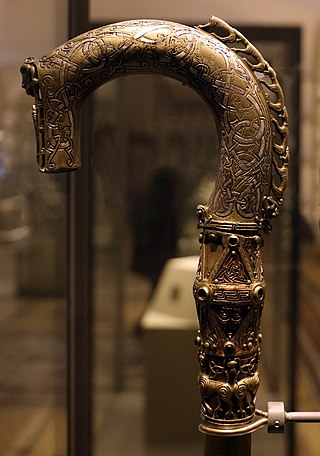
An Insular crozier is a type of processional bishop's staff (crozier) produced in Ireland and Scotland between 800 and 1200. Such items can be distinguished from mainland European types by their curved and open crooks, and drop. By the end of the 12th century, production of Irish croziers had largely ended, but examples continued to be reworked and added to throughout the Romanesque and Gothic periods. Although many of the croziers are associated with 5th- and 6th-century saints, the objects were not made until long after the saints had died. A majority originate from around the 9th century, and were often used as embellishment between the 11th and 13th centuries.

The Clonmacnoise Crozier is a late-11th-century Insular crozier that would have been used as a ceremonial staff for bishops and mitred abbots. Its origins and medieval provenance are unknown. It was likely discovered in the late 18th or early 19th century in the monastery of Clonmacnoise in County Offaly, Ireland. The crozier has two main parts: a long shaft and a curved crook. Its style reflects elements of Viking art, especially the snake-like animals in figure-of-eight patterns running on the sides of the body of the crook, and the ribbon of dog-like animals in openwork that form the crest at its top. Apart from a shortening to the staff length and the loss of some inserted gems, it is largely intact and is one of the best-preserved surviving pieces of Insular metalwork.
Griffin Murray is an Irish archaeologist and art historian specialising in medieval Ireland and Insular art–especially metalwork–in the period between 400–1550 AD. His interests include identifying and contextualizing the social role of medieval craftsmen, Viking art and the relations between insular and Scandinavian craftsmen, and he is a leading expert on both house-shaped shrines and insular croziers.

The Lismore Crozier is an Irish Insular-type crozier dated to between 1100 and 1113 AD. It consists of a wooden tubular staff lined with copper-alloy plates; embellished with silver, gold, niello and glass; and capped by a crook with a decorative openwork crest. The inscriptions on the upper knope record that it was built by "Nechtain the craftsman" and commissioned by Niall mac Meic Aeducain, bishop of Lismore. This makes it the only extant insular crozier to be inscribed, and the only one whose date of origin can be closely approximated. It was rediscovered in 1814, along with the 15th-century Book of Lismore, in a walled-up doorway in Lismore Castle, County Waterford, where it was probably hidden in the late Middle Ages during a period of either religious persecution or raids.

The Prosperous Crozier is a late 9th-century or early 10-century Irish Insular type crozier that would have been used as a ceremonial staff for bishops and high-status abbots. Its origins and medieval provenance are unknown until it was found fully intact by turf cutters c. 1831 near Prosperous, County Kildare. It but did not receive attention from antiquarians until 1851, but is today identified as one of the earliest fully extant and thus perhaps the most historically important European crozier.
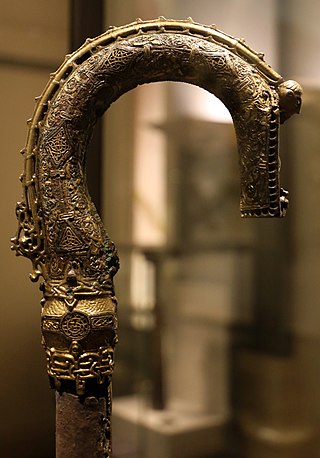
The River Laune Crozier is a late 11th-century Insular crozier, now at the Archaeology branch of the National Museum of Ireland. The object would have been commissioned as a staff of office for a senior clergyman, most likely a bishop. It consists of a wooden core decorated with fitted bronze and silver metal plates. Although the metalwork is somewhat corroded in parts, it is fully intact and considered one of the finest surviving Irish examples, alongside those found at Clonmacnoise and Lismore.
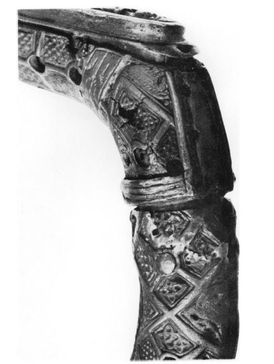
St. Mel's Crozier was a fully intact 10th or 11th century Insular crozier discovered in the mid-19th century on the grounds of an early medieval church in Ardagh, County Longford. It consisted of a wooden core lined with metal sheet tubing decorated with silver, coral and glass, as well as three knopes and a ring towards its base. The drop plate was formed by a separately formed wood block, and added to in the 12th century with a figure of a cleric or bishop wearing a mitre and holding a staff.
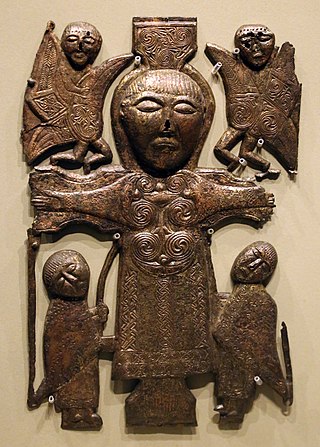
The term Crucifixion plaque refers to small early medieval sculptures with a central panel of the still alive but crucified Jesus surrounded by four smaller ancillary panels, consisting of Stephaton and Longinus in the lower quadrants, and two hovering attendant angels in the quadrants above his arms. Notable examples are found in classical Roman and 8th to mid-12th century Irish Insular art.

The Corp Naomh is an Irish bell shrine made in the 9th or 10th century to enclose a now-lost hand-bell, which probably dated to c. 600 to 900 AD and belonged to an early Irish saint. The shrine was rediscovered sometime before 1682 at Tristernagh Abbey, near Templecross, County Westmeath. The shrine is 23 cm (9.1 in) high and 12 cm (4.7 in) wide. It was heavily refurbished and added to during a second phase of embellishment in the 15th century, and now consists of cast and sheet bronze plates mounted on a wooden core decorated with silver, niello and rock crystal. It is severely damaged with extensive losses and wear across almost all of its parts, and when discovered a block of wood had been substituted for the bell itself. The remaining elements are considered of high historical and artistic value by archeologists and art historians.

The Shrine of St Patrick's Tooth is a medieval reliquary traditionally believed to contain a tooth belonging to Patrick, Ireland's patron saint, who lived in the 5th century. The shrine comprises a wooden case lined with bronze and decorated with gold, silver and amber fittings, and was built in two phases. Its basic structure and the central ringed crosses on either side are 12th century, while the purse-shaped form and most of the metal work, including the saints, were added in the 1370s when the object was substantially refurbished.























